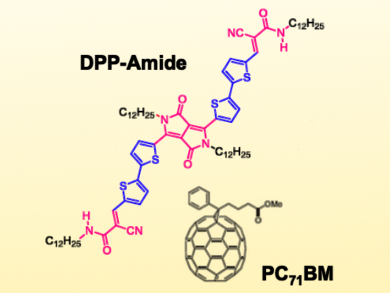Organogels can be an excellent platform for efficient energy- and electron transfer. This is a prerequisite for optoelectronic devices such as organic light emitting diodes (OLEDs) and organic solar cells (OSCs).
Ayyappanpillai Ajayaghosh, CSIR-National Institute for Interdisciplinary Science and Technology (CSIR-NIIST), Trivandrum, India, and colleagues have developed a hybrid organogel consisting of a diketopyrrolopyrrole based p-type organogelator and a fullerene derivative as an electron acceptor (components pictured). The diketopyrrolopyrrole derivative undergoes a supramolecular organization through extensive hydrogen bonding in non-polar solvents, which results in gelation.
This conjugate p-type gelator shows very broad absorption and a low band gap, which maximizes the use of sunlight. The researchers found that the resulting self-assembled nanofibers show enhanced intrinsic photoconductivity upon the addition of a fullerene-based acceptor. The increase in photoconductivity is attributed to the efficient photoinduced charge separation at the donor-acceptor interface.
- A Hybrid Organogel of a Low Band Gap Diketopyrrolopyrrole with PC71BM: Phase Separated Morphology and Enhanced Photoconductivity,
Samrat Ghosh, Satyajit Das, Akinori Saeki, Vakayil K. Praveen, Shu Seki, Ayyappanpillai Ajayaghosh,
ChemNanoMat 2018.
https://doi.org/10.1002/cnma.201800149




